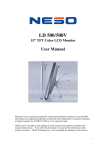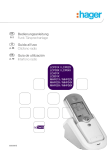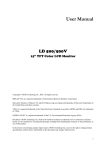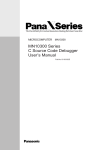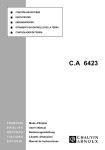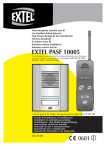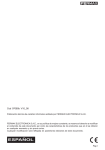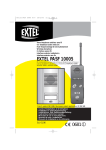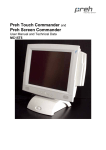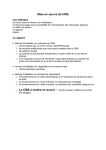Download Installer Guide - pdf 6.4Mb
Transcript
DE S. 2 IT p. 60 ES p. 118 GB p. 176 804480/A Montageanleitung Funk-Türsprechanlage Manuale d’installazione Citofono radio Manual de instalación Interfono radio Installation manual Doorphone LCP01X / LCP02X LCP03X / LCP04X LCP01U / LCP02U LCP03U / LCP04U LCA01U / LCA01X LCB01X MHF01X / MHF02X MHF03X / MHF04X MHF05X / MHF06X GB This manual describes how to install the following products: LCP01U/LCP01X 1-button 1-home doorphone kit LCP02U/LCP02X Code-operated 1-home doorphone kit LCP03U/LCP03X 2-button 2-home doorphone kit LCP03U/LCP03X Code-operated 2-home doorphone kit LCA01U/LCA01X Interior handset unit + base + EU power pack LCB01X Controller MHF01X Translucent 2-home outdoor caller unit MHF02X Translucent code-operated 2-home outdoor caller unit MHF03X Opaque 1-home outdoor caller unit MHF04X Opaque 2-home outdoor caller unit MHF05X Opaque code-operated 1-home outdoor caller unit MHF06X Opaque code-operated 2-home outdoor caller unit Foreword The doorphone system can be used to welcome and filter visitors, listen in to background sounds at each access point and communicate with another handset. It can also be used to remotely control: • one or several electrical latches, • one or several automatic gate control systems, • one or several automatic garage door control systems, • one or several lights. It also allows users to check the status of access points or lights using the screen on the handset at any time. Several additional interior handset units can be added to the doorphone system (maximum of 4 per call button). DECLARATION OF CONFORMITY GB 10 Manufacturer: Hager Security SAS Address: F-38926 Crolles Cedex - France Product type: Doorphone Trade mark: Hager We declare under our sole responsibility that the products to which this declaration relates are compliant with the essential requirements of the following directives: • R&TTE Directive: 99/5/CE • Low Voltage Directive: 2006/95/CE • ROHS directive: 2002/95/CE in compliance with the following harmonised European standards: Product reference EN 300 220-2 V2.1.2 EN 60950 (2006) EN 301 489-1 V1.8.1 LCA01U LCB01X LCA01X X X X X X X DECLARATION OF CONFORMITY GB Manufacturer: Hager Security SAS 10 Address: F-38926 Crolles Cedex - France Product type: Doorphone Trade mark: Hager We declare under our sole responsibility that the products to which this declaration relates are compliant with the essential requirements of the following directives: • R&TTE Directive: 99/5/CE • Low Voltage Directive: 2006/95/CE • ROHS directive: 2002/95/CE in compliance with the following harmonised European standards: Product reference MHF01X MHF02X MHF03X MHF04X MHF05X MHF06X EN 300 330-2 V1.3.1 X X X X X X X X X X X X EN 60950 (2006) X X X X X X EN 301 489-1 V1.8.1 These products can be used in all EU and EEA countries and Switzerland. Crolles, 06/05/10 These products can be used in all EU and EEA countries and Switzerland. Signature : Patrick Bernard Research & Development Director Crolles, 06/05/10 Signature : Patrick Bernard, Research & Development Director Non-binding document, subject to modification without notice. 176 GB Contents 1. Introduction ............................................................................................................................ 178 2. Description.............................................................................................................................. 180 2.1 Outdoor system ................................................................................................................. 180 2.2 Interior handset unit ........................................................................................................... 180 3. Tooling required ..................................................................................................................... 184 4. Preparation ............................................................................................................................. 185 4.1 Guarantee stickers............................................................................................................. 185 4.2 Charging the handset before installation .......................................................................... 186 5 Installing the outdoor system ............................................................................................... 189 5.1 Installing the outdoor caller unit ........................................................................................ 189 5.2 Installing the controller....................................................................................................... 194 5.3 Connecting the equipment................................................................................................ 195 5.4 Powering the controller...................................................................................................... 198 5.5 Creating the radio link between the handset and the controller ...................................... 200 6. Testing the radio range ......................................................................................................... 203 7. Installing the interior handset unit ...................................................................................... 204 7.1 On a table........................................................................................................................... 204 7.2 On a wall ............................................................................................................................ 204 8. Testing operation ................................................................................................................... 208 8.1 Testing communication with each interior handset unit ................................................... 208 8.2 Testing access controls ..................................................................................................... 209 9. Appendices............................................................................................................................. 210 9.1 General information about creating the radio link ............................................................ 210 9.2 Testing the radio link .......................................................................................................... 223 9.3 Deleting radio links and returning to factory programming.............................................. 225 10 Changing the batteries ........................................................................................................ 229 10.1 In the main controller ....................................................................................................... 229 10.2 In the handset .................................................................................................................. 230 11. Questions - Answers........................................................................................................... 231 12. Technical data ...................................................................................................................... 233 177 GB 1. Introduction DOORPHONE SYSTEM COMPONENTS Outdoor caller units wired to main controller (road side) 1 call button + tag reader 2 call buttons + tag reader OUTDOOR SYSTEM 1 call button with keypad + tag reader 2 call buttons with keypad + tag reader Main controller (garden side) Connection of gate motorisation system Connection of an electrical latch or lock ))) ) ) ) ) )) ) ) ) ) )) ) INTERIOR HANDSET UNIT )))))))))))))))) Handset units can communicate with each other (inter-handset communication function) Handset Base 178 GB Each kit comprises the following (minimum): • An outdoor caller unit installed on the road side, for visitors. • A controller installed on the same pillar but on the garden side. This controller provides: - the radio link with the interior handset unit, - the power supply to the outdoor caller unit and controller, - the connections to the electrical lock or latch and gate motorisation system. These products are connected via a cable that either goes through or around the pillar. • An interior handset unit (base and handset) for receiving calls and remotely controlling: - the electrical locks or latches, - the gate motorisation system, - the automatic garage door control system (1), - lighting (1), - communication with another handset (2), - doorphone programming. Using the outdoor caller unit, access is controlled using: • an access code, • a tag reader. The outdoor caller unit with keypad can manage up to 16 different tags. Each tag must be registered on the caller unit. 25 mm Identifying each user with a tag The outdoor caller units have a front panel with a tag reading zone allowing each user to control access quickly once the tag has been identified. Holding the tag up to the name label dispenses the user from entering the access code. Mr et Mme Evêque-Mourroux The tag is detected in this zone at a maximum distance of 20 mm 1) Via output receiver. 2) Requires a minimum of 2 handsets. 179 GB 2. Description 2.1 Outdoor system 2.1.1 Outdoor caller units with armoured cover Loudspeaker Programming keypad for entering access code to allow pedestrians and cars to enter Call button (1 or 2 depending on model) 4 handsets max. per button Gate access control button Blank label for user’s name (sheet of labels supplied) Tag reading zone Latch/side gate access control button Tag reading zone Slot for batteries (LR20 type, not supplied) 2.1.2 Controller Cover Captive screws for bracket fixing Controller base Fixing bracket 4 captive screws for closing the cover Validation button Radio link creation LED Grommet (remove) IMPORTANT: the grommets, cable clamps and screws for the cable clamps are in the bag of accessories. Cable clamp (do not remove) Connection terminal blocks 2.2 Interior handset unit 2.2.1 Base Power pack Transparent removable cover Handset base 180 Base connection jack Radio link creation button GB 2.2.2 Handset unit IMPORTANT: when installing the system, the handset(s) must be charged on their base before they can be used. Cover closed Cover open Removable belt clip Loudspeaker Display C F C F Communication button Latch/side gate control button Garage control button (1) Inter-handset communication button Lighting control button (1) Gate control button Up and down scroll keys Validate button (OK) Cancel button Microphone Backlighting is activated whenever a button is pressed. It goes out again after 5 seconds when no other button is pressed. Left and right scroll keys Flip cover (1) These functions require a relay output receiver to be installed. 181 GB 2.2.3 Display description Handset battery status flat Radio range Communication in progress Handset in silent mode no signal Missed call needs charging poor charging recommended average good fully charged excellent charging Indoor temperature Scrolling text zone: - display of time - outdoor temperature - faults - access calling - current commands - handset mode C F Temperature unit: - °C: Celsius - °F: Fahrenheit Garage status garages closed Fault garages open Indoor temperature indication Handset in inter-handset communication mode garage 1 open 2 closed Garage, side gate and latch status gate closed gate open garage 1 closed 2 open Lighting status gate 1 open/2 closed or gate half open if sliding motor lighting off gate 1 closed/2 open or side gate open lighting on latch closed IMPORTANT: only the icons corresponding to the installation are displayed. latch open 182 GB 2.2.4 Handset display in standby mode (general information screen) Handset battery status Outdoor temperature The temperature displayed is measured at the first access point programmed. Time C Indoor temperature The temperature displayed is the handset temperature. Garage status Gate, side gate and latch status 183 Lighting status GB 3. Tooling required 6/8 mm PZ 0 3 mm PZ 2 6 mm 3.5 mm GUARANTEE The conditions according to which the guarantee and after sales service apply are described in the general price list and can be sent on request. Some after sales service products and accessories, such as: • MHU01X or MHU01U power packs • LCH01X interior handset unit base • LCH02X belt clip • LCH03X handset flip cover (non-exhaustive list for indication purposes only) have a 2-year manufacturer guarantee, which cannot be extended. 184 GB 4. Preparation 4.1 Guarantee stickers Remove the pre-cut parts of the stickers and stick these to the extension request supplied. On the back of the caller unit MHF01X On the handset Coller sur certif A0831A04823 LCA01F Coller sur certif A0831A04823 Inside the controller 1. Unscrew the 4 cover screws and open the controller. 2. Remove the pre-cut part. LCB01F A0831A04823 LCB01F A0831A04823 Pozidriv 2 185 Coller sur certif GB 4.2 Charging the handset before installation IMPORTANT: when installing the system, the handset(s) must be charged on the base before it/they can be used. 1. Open the base. 2. Remove the 4 anti-slip pads. ➁ ➀ 3. Rotate the back of the base until it is in “table” position. 4. Thread the power pack jack through the hole. 5. Connect the jack to the base making sure that the cable is positioned in the designated slot. IMPORTANT: only MHU01X or MHU01U power packs supplied must be used. Thread the cable through here 186 Alternative cable passage GB 6. Thread the power cable into one of the guides at the back of the base. 7. Unscrew the locking screw. Pozidriv 0 Alternative guides 8. Screw it back into the same place hence locking the base in “table” position. 9. Close the base. Pozidriv 0 10. Tighten the locking screw to prevent the base from being opened by mistake. 11. Stick the 4 anti-slip pads to the back of the base and then put it on the table. Pozidriv 2 187 GB 12. Connect the power pack to the mains (220 V). 13. Put the handset on the base. The handset displays this message for 2 sec.: Electrical shock hazard Then IN CHARGE if the battery is not sufficiently charged. IMPORTANT: the mains socket must remain accessible so that the power pack can be easily disconnected. or If the battery is sufficiently charged. You can now move on to the next chapter describing how to install the doorphone. TIP: to make it easier to pick the handset up, the removable transparent cover can be removed. ➀ ➁ 188 GB 5. Installing the outdoor system 5.1 Installing the outdoor caller unit IMPORTANT: to ensure the outdoor caller unit remains watertight, never try to open it! 1. To ensure easy use, fix the unit at a height of 1.20 m. 2. Mark and drill the outdoor caller unit holes with a Ø 6 mm drill bit. Also mark the place where the cable feed hole has to be drilled (Ø 8 mm min. recommended). 1.20 m Please refer to the next chapter for mounting outdoor caller units with armoured cover. Follow steps 3 to 6 below for units without armoured cover. 3. If the cable goes around the pillar, pierce one of the cable knock-outs with a cutter. 4. Push the screw covers out using a flat screwdriver. 3.5 5. Thread the cable through the hole knocked out in step 3 and screw the caller unit in place. Put the screw covers back. 6. Use a pencil or permanent marker to write the names. Stick a transparent protection label on top. TIP: you can print the labels using the software (EtikPrint) available on the Hager web site. Pozidriv 2 189 160.4 mm 232.4 mm GB Mounting the outdoor caller units with armoured cover 145 mm TIP: you can print the labels using the software (EtikPrint) available on the Hager web site. 145 mm 145 mm 145 mm IMPORTANT: use the label supplied and carefully position it in the space provided. 1 2 190 GB 4 3 5 6 Pozidriv 2 191 GB 7 3.5 8 9 192 GB 10 11 IMPORTANT: when the armoured cover is positioned on the unit, there should be a 1 mm clearance (use the shim for this purpose) between the pillar and armoured cover. 12 Pozidriv 2 193 GB 5.2 Installing the controller 1. Unscrew the locking screw from the bracket and then remove it. 2. Following the installation rules below, mark 3 fixing points and drill a hole in the pillar using a Ø 6 mm drill bit. Pozidriv 2 4 cm minimum Outdoor caller unit cable feed Installation rules To make it easier to hook the base on to the bracket choose a flat surface (or make the surface as flat as possible) on the garden side of the pillar. This is especially important for the top part of the bracket. To guarantee an excellent radio range: • keep the space clear around the controller, • remove any dense vegetation nearby and make sure the area is always clear, • place the controller as high up as possible (80 cm min.). • make sure there are no obstacles between the controller installation point and the house where the handset(s) is/are installed. as high as possible outdoor caller unit Never run a cable over the top of the controller (especially the cable ensuring the radio link between the outdoor caller unit and the controller). Do not wind the cable up nearby or inside the controller. Instead, cut off any excess length. caller unit cable outdoor caller unit caller unit cable Do not place the products near metal surfaces (screens, fences, gates, etc.) or sources of electromagnetic disturbance: • for the controller: electricity meter, high voltage line, lighting control system, radio receiver, etc. • for the handset: hi-fi equipment, video, household appliance, electricity meter or switchboard, lighting control system, etc. • the controller must be more than 3 m away from the interior handset unit. 194 GB 3. Insert a washer and fix the bottom and then the top of the bracket. 4. Hook the base on to the fixing bracket. Fixing without a washer ➀ Detach and dispose of unused washers Pozidriv 2 ➁ Fixing with a washer 5. Lock the base in place using the locking screw. Pozidriv 2 5.3 Connecting the equipment 1. To make it possible to thread the cables through (for the outdoor caller unit, external power supply, motorisation system, etc.), remove the grommets and pierce a hole with the same diameter as the cable using a Philips screwdriver. 2. Cut the cables to the necessary length and then thread them through the grommets. Expose the end of the wires over a length of approximately 1 cm. The cables must be entirely unwound. 195 GB TIP: • All terminal blocks can be unplugged to facilitate wiring. • The connections to be made are summarised on a label inside the controller cover. 3. Connecting the outdoor caller unit Connect the 4 outdoor caller unit wires to terminal blocks 15 to 18 on the controller. 15 16 17 18 - + 15/Green: Data – 16/Yellow: Data + 17/Red: power + 18/Black: power – 3.5 (( (( TIP: if the cable between the outdoor caller unit and the controller has to be lengthened, cut it at a distance of 1 m and then extend the red and black wires according to the rules below: - 0.32 mm2 min. up to 10 m, - 0.75 mm2 min. up to 15 m, - 1.5 mm2 min. up to 25 m. Extend the other wires using a telephone type cable and make the connections via a branch box. 4. Connecting an electrical latch Connect the latch according to the following cable cross-sections: - in 3 and 4: 0.75 mm2 up to 15 m/1.5 mm2 up to 30 m, - in 5, 6, 7 and 8: 0.22 mm2 (telephone type wire). 3 IMPORTANT: so that the system recognises the latch, it must be wired before the radio link is created between the handset and the controller. - 4 5 6 7 8 + 3.5 Push-button located on the garden side for manual latch control. Place this control device out of reach and sight in relation to the road (connection not compulsory). Electrical latch or lock control (no need for external power supply) 12 V 1.5 A max. The position contact feeds back the latch status to the screen: NC IMPORTANT: for the information feedback to be properly managed, the position contact (ref. CP500 on the price list) must be wired before power-up and be in closed position when the radio link is established between the handset and the controller. If no contact is connected, the handset display will show the latch is closed whatever its status. 196 - latch closed (contact closed), - latch open (contact open). GB 5. Connecting a gate motorisation system Use a cable cross-section of 22 mm2 (telephone type wire) to connect the system. IMPORTANT: for the information feedback to be properly managed, the position contact (ref. CP500 on the price list) must be wired before power-up and be in closed position when the radio link is established between the handset and the controller. If no contact is connected, the handset display will show the gate is closed whatever its status. 9 10 11 12 13 14 C ▼▼ NC NO 3.5 If a push-button allowing manual control of the automatic system has already been installed, connect terminal blocks 12 and 14 in parallel on this manual control input. NC The position contact feeds back the gate status to the screen: - gate closed (contact closed), - gate open (contact open). Gate motorisation control, 48 V DC/1 A dry contact relay output. The motorisation system requires an external power supply. 197 GB 5.4 Powering the controller 1. Two types of power supply can be used. • Battery Position the 4 LR20 1.5 V batteries (not supplied) making sure they are the right way round. + + + IMPORTANT: push the batteries into their slot making sure that the + pole of each one is in contact with the metal part. + • Transformer Connect a 12/24 V AC or 12/30 V DC power pack to terminal blocks 1 and 2 of the controller (transformer A7901 available in the catalogue). There are no polarities to be respected on these terminals. 230 V input 3.5 IMPORTANT: the transformer used must have the 12 V/10 VA min. double insulation symbol (230 V power supply without an earth connection). 12 V output Transformer Cable length and cross-section 0 to 10 m ➞ 0.32 mm2 10 to 25 m ➞ 0.75 mm2 Optional Position the 4 LR20 1.5 V batteries (not supplied) making sure they are the right way round. The batteries are used as back-up in the event of a mains power failure. + + + + 198 GB 2. When powered, the outdoor caller unit lights up and beeps every 2 sec. The radio link creation LED also lights up red for 2 sec. If this is not the case, check that the controller’s batteries or external power supply are properly connected. If the radio link creation LED flashes three times every 5 seconds: - remove the controller’s power supply, - check the outdoor caller unit wiring, - reconnect the controller’s power supply. Mr et Mme Evêque-Mourroux “BEEP” 3. To ensure the controller is watertight, all the grommets must be positioned and locked into place the right way round. 4. Use the cable clamp and screws provided to lock the cables in place. Do not loosen the cable clamps. Pozidriv 2 199 GB 5.5 Creating the radio link between the handset and the controller IMPORTANT: each call button on the outdoor caller unit can be linked via radio with up to 4 handsets. 1. At this stage in the installation procedure, the handset should display: If this is not the case, the handset needs to be charged (see chapter on Charging the handset before installation) until the language selection message is displayed. 2. Pick up the handset, open the cover and select the desired language (1) using the following keys then . The handset beeps for 2 sec. 3. Programme the time (1): A/ set the first digit using the keys B/ set the next digit using the key The . key selects the previous character C/ return to steps A and B to set the minutes and then, once the desired time has been programmed, press . The handset beeps for 2 sec. 4. The handset then moves on to radio link set-up mode and displays: 5. Pick up the handset, stand next to the controller and follow the procedure on the next page: (1) These parameters can be modified at a later stage (see User manual/Modifying handset operating options/Modifying options for use). 200 GB Controller Handset unit Outdoor caller unit 6. Put the controller in radio link creation mode by pressing The radio link creation LED lights up orange. 7. The radio link creation LED lights up orange. The handset displays: 8. Press once on the outdoor caller unit so that it calls the handset. IMPORTANT: when using a translucent MHF01X or MHF02X outdoor caller unit and 1-button armoured cover, only the bottom key (KEY 1) can be accessed once the armoured cover has been placed on the unit. + = KEY 1 + = 201 GB Controller Handset unit Outdoor caller unit 9. The handset displays: then Display of time, indoor and outdoor temperature, gate, side gate and latch status (if position contacts connected). The radio link LED lights up green for 2 sec. beeps for 2 sec and The outdoor caller unit beeps for 2 sec. C “BEEP” The radio link has been created. If an error occurs, the handset displays: It beeps 3 times and then automatically returns to the next screen: Carry out the radio link creation procedure again for all the handsets. Close the controller. Pozidriv 2 202 Start the radio link creation procedure again. GB 6. Testing the radio range Before installing the handset base, make sure the radio range between the handset and the controller(s) is good. 1. Stand in the place you wish to install the handset unit and quickly press the key. 2. If you have several access points: select the access point from where you would like to listen in to background sounds using the keys then C . 3. You can hear what is happening around the outdoor caller unit at the selected access point. Reception is good if at least 3 bars are displayed. If this is not the case, move the handset. Radio range bar graph C 4. Press on the key and test the radio range again for each access point. IMPORTANT: if the handset units or controllers are too close to each other when you are testing the radio link, this may generate interference (Larsen effects, crackling, etc.). Move the various devices over 3 metres away from each other. 203 GB 7. Installing the interior handset unit 7.1 On a table The table mounting procedure is described in the chapter on Charging the handset unit before installation. 7.2 On a wall This chapter describes how to move the handset unit from a “table” position (in which the handset unit is normally placed at this stage in the installation, see chapter on Charging the handset unit before installation) to a “wall” position. 1. Remove the handset from the base. 2. IMPORTANT: the removable transparent cover must be in place when fixing the unit to the wall. If this is not the case, clip it back on. 3. Disconnect the power pack. Electrical shock hazard 204 GB 4. Unscrew the base locking screw. 5. Open the base. ➁ ➀ Pozidriv 2 6. Unscrew the locking screw. 7. Insert the screw here and tighten it. Pozidriv 0 Pozidriv 0 8. Rotate the back of the base until it is in wall position. 205 GB 9. Mark the 2 fixing points and then make a hole using a Ø 6 mm drill bit. roughly 1.5 m high 10. Check the power pack jack is in the right position. Thread the cable through here 11. Thread the power cable into one of the guides at the back of the base. Other guides possible Alternative cable passage 12. Fix the base to the wall using appropriate washers and screws. 13. Close the base. Pozidriv 2 206 GB 14. Tighten the locking screw. 15. Connect the power pack (220 V). Electrical shock hazard Pozidriv 2 IMPORTANT: the mains socket must remain accessible so that the power pack can be easily disconnected. 16. Place the handset on the base. The handset beeps once. C If necessary, the icon flashes to show the handset is being charged. 207 GB 8. Testing operation 8.1 Testing communication with each interior handset unit 1. Press on the outdoor caller unit call button. IMPORTANT If the handset being called is already: • communicating with another outdoor caller unit or handset, • outside the radio range, the outdoor caller unit sounds engaged. To confirm the call, the outdoor caller unit rings at regular intervals for 30 sec. 2. The handset rings (1) (except if it is in silent mode), and the backlighting flashes. C 3. If the handset is on its base, pick it up: - if the automatic pick-up mode is activated, communication is established - otherwise, press the key. The name of the access point calling (2) is displayed. C 2. If the handset is already off the base, press . volume + 4. Open the flip cover to talk and adjust the audio communication volume using the keys. volume – 5. At the end of communication, press and/or put the handset back on the base to hang up (the handset issues 3 beeps if it is correctly placed on the base). C If no button is pressed, the communication is automatically cut off after 3 minutes. Perform the same test for all of the handsets. (1) If there is no answer, the handset rings for 20 sec. (factory setting). The duration of ringing can be adjusted (see Programming handset operating options). If the handset is on the base, it rings at the programmed volume (see Modifying handset operating options). If the handset is off the base, ringing gradually becomes louder (from level 1 to the programmed volume). (2) Access point names can be customised (see Modifying doorphone operating options). 208 GB 8.2 Testing access controls IMPORTANT: to test the access controls, it is first necessary to register a tag or programme an access code on the outdoor caller unit (see User manual/Modifying outdoor caller unit operating options). Activate the outdoor caller unit Status display on the handset (1) Latch access status 1. Hold the tag in front of the name label. Mr et Mme Evêque-Mourroux 1. Or enter the access code (2) C Mr et Mme Evêque-Mourroux Closed 2. If a latch is connected, it will be unlocked within 5 seconds. Open C or or 2. If a gate alone is connected (without a latch), side gate access is unlocked within 5 seconds. C For additional tests (gate access, listen-in and inter-handset communication functions, etc.), please refer to the corresponding chapters in the user manual. The doorphone is now operational. If need be, you can customise it by following the instructions in the chapters on Modifying outdoor caller unit operating options and Modifying handset operating options in the user manual. (1) If a position contact is connected. (2) If you press the wrong button, press then enter the access code again. 209 GB 9. Appendices 9.1 General information about creating the radio link An OPTWIN installation is a home-control system in which all the doorphone products communicate with each other via radio. It comprises different types of products that can be classed according to their function at a given time T in the installation: • “Transmitter” products: these send commands or information following actions (e.g. when the handset Light button is pressed) or events (e.g. when the gate is closed via the controller). A “Transmitter” product can generate several different commands (e.g. Light or Garage buttons on the handset). • “Receiver” products: these receive commands and information and activate the appropriate applications (lighting, automatic control system, etc.) or respond according to their programming. These applications or responses are also called functions. A “Receiver” product can have several functions (e.g. 2-channel relay output receiver, strobe and siren sounding, etc.). It should be noted that products may act as “Transmitters” and “Receivers”. Examples: Audio communication between the handset and the outdoor caller unit. The handset is considered as the receiver while the controller/outdoor caller unit act as the transmitter. ))))))))))))) The Light button on the handset controls the lighting connected to the relay output receiver. The handset is considered as the transmitter while the output receiver acts as the receiver. ))))))))))))) 210 GB Configuring an OPTWIN installation consists in: • creating radio links between the different transmitter and receiver products to define who controls who and who sends information to whom. • allocating a function to each radio link, e.g. when the Light button on the handset is pressed, this activates the lighting controlled by the output receiver for 5 minutes. A radio link is created and a function is allocated to this radio link as part of the same procedure. This procedure is as follows: Transmitter Receiver 1. Switch to radio link creation mode. 2. Switch to radio link creation mode. 3. Select the function. 4. Select the button or event associated with the function. 5. Validate the procedure. 211 GB 9.1.1 The controller is used as a transmitter Application examples By creating a radio link between a controller and an output receiver, the following applications can be set up: • gate opening can switch on lighting to facilitate night time access and gate closing can switch off lighting, • electrical latch opening can switch on courtesy lighting for a programmable duration, • etc. )))))))))))))))) Radio link to be created • pressing on the outdoor caller unit call button can trigger a door bell installed elsewhere for a programmable duration. )))))))))))))))) (( Radio link to be created Controller (( Receiver 1. Switch to radio link creation mode. Press on the key. The radio link LED lights up orange. 2. Switch to radio link creation mode. 3. Select the function. Information available in the receiver product manual. 212 GB Controller Receiver 4. Select the event associated with the function. Using the display. , keys and controller Event N° Event name 1 Gate opening 2 Gate closed Comment This event is displayed when the gate is opened This event is displayed when the gate closes, as long as limit switches have been wired. 3 Latch opening 4 Side gate closed This event is displayed when the latch is opened 5 Day breaking This event is displayed when the day breaks. Useful for switching off night lighting. 6 Night falling This event is displayed when the night falls. Useful for switching on night lighting. This event is displayed when the side gate closes, as long as limit switches have been wired. or 4. Select the key associated with the function. Press: gate , latch , or call on the outdoor caller unit. IMPORTANT: step 5 is not necessary if the outdoor caller unit gate, latch or call buttons have been selected. 213 GB Controller Receiver 5. Validate the procedure. Press on the key. The radio link creation LED lights up green for 2 sec. Otherwise, start the procedure again. The radio link has been created. IMPORTANT: if an error occurs, the radio link LED flashes red 3 times. The radio link creation process should be performed again in this case. 214 GB 9.1.2 The handset is used as a transmitter Application examples By creating a radio link between the the following applications can be set up: or keys on the handset and an output receiver, Radio link n° 1 Press once on the key to open the garage door and press again to close. ))))) ) ) ) ) ) ) ) ) ) )) )))))))))) )))))) Radio link n° 2 Press once on the key to switch on lighting for a programmable duration. Handset Receiver 1. Switch to radio link creation mode. Display the following screen using the keys C C C 215 GB Handset Receiver 2. Switch to radio link creation mode. 3. Select the function. Information available in the receiver product manual. 4. Select the key associated with the function. C Press on the or key C C then Select a command from the following: GARAGE 1 GARAGE 2 GARAGE 3 GARAGE 4 or LIGHT 1 LIGHT 2 LIGHT 3 LIGHT 4 Using the keys 216 GB Handset Receiver 5. Validate the procedure. Press on the key. The handset displays: C then C beeps for 2 sec and C Garage or light icon displayed The radio link has been created. If an error occurs, the handset displays: C It beeps 3 times and then automatically returns to the general information screen: 217 Perform the radio link creation procedure again. C GB 9.1.3 Specific cases • Creating a radio link between a handset and several controllers or several outdoor caller unit buttons A handset can be associated with 4 different inputs. By creating a radio link between the handset and the controller (see chapter on Installing the doorphone), you have created radio link n° 1 (e.g. handset programmed for the 1st call button and input 1). Radio link n° 2 (2nd call button) ))))))))))))))))))))) ))))))))))))))))))))) Radio link n° 1 (1st call button) Input 2 )) ) )) ) ) )) )))))) )) )) Radio link n° 4 )) Radio link n° 3 )) )) ) )) Input 1 Input 3 Radio link n° 5 Input 4 To create radio links n° 2, n° 3, n° 4 and n° 5, follow the procedure below: Controller Handset 1. Switch the controller to radio link creation mode by pressing . The radio link creation LED lights up orange. 218 Outdoor caller unit GB Controller Handset Outdoor caller unit 2. Switch the handset to radio link creation mode. Display the following screen using the keys C C C The radio link creation LED flashes orange. 3. Press once on the outdoor caller unit call button to call the handset. IMPORTANT: If you are using an MHF01X or MHF02X translucent outdoor caller unit and a 1-button armoured cover, only the bottom button (KEY 1) is accessible once the cover is in place. + = KEY 1 + = 219 GB Controller Handset Outdoor caller unit 4. The handset displays: C then C The radio link creation LED lights up green for 2 sec. beeps for 2 sec. and C “BEEP” The radio link has been created. If an error occurs, the handset displays: C It beeps 3 times and then automatically returns to the general information screen: 220 Perform the radio link creation procedure again. C GB • Creating a radio link between several handsets IMPORTANT: each handset can be linked via radio with a maximum of 7 other handsets. To allow several handsets to communicate with each other (inter-handset communication), a radio link has to be created between each one. To do this, proceed as follows: 1st handset 2nd handset 1. Switch the handset to radio link creation mode. Display the following screen using the keys C C 2. Switch the handset to radio link creation mode. Display the following screen using the keys C C C C C 221 GB 1st handset 2nd handset 3. Press 4. The handset displays: 4. The handset displays: C C then then C C beeps for 2 sec. and beeps for 2 sec. and C C The radio link has been created If an error occurs, the handset displays: C It beeps 3 times and then automatically returns to the general information screen: 222 Perform the radio link creation procedure again. C GB 9.2 Testing the radio link This function is used to test the radio links created between a handset and a controller. To do this, open the controller cover and proceed as follows: Handset Controller 1. Switch the handset to radio link test mode. Display the following screen using the keys C C C C 2. Press or . C 223 GB Handset Controller 3. Select the controller to be tested using the keys 4. Press again on The controller screen displays “1”. The key is linked via radio to the controller gate output. or . The controller screen displays “2”. The key is linked via radio to the controller side gate output. The controller screen displays “3”. The key is linked via radio to the controller latch output. 5. Press twice on The controller beeps 3 times and the display goes out. 6. After several seconds the handset exits radio link test mode and returns to the general information screen. 224 GB 9.3 Deleting radio links and returning to factory programming 9.3.1 Deleting a radio link between a controller and a handset This function is used to delete the radio links created between a controller and a handset. Controller Handset Outdoor caller unit 1. Press The radio link creation LED lights up orange. 2. Switch the handset to radio link deletion mode. Display the following screen using the keys C C C 225 GB Controller Handset Outdoor caller unit C The radio link creation LED flashes orange. 3. Press once on the outdoor caller unit call button to call the handset. 4. The handset displays: C then C The radio link creation LED lights up green for 2 sec. beeps for 2 sec. and The outdoor caller unit beeps for 2 sec. C “BEEP” The radio link has been deleted. If an error occurs, the handset displays: C It beeps 3 times and then automatically returns to the general information screen: 226 Perform the radio link deletion procedure again. C GB 9.3.2 Returning the handset and controller to factory programming This procedure is used to delete all the radio links and reset all handset and controller parameters to their factory value. 1. Switch the handset to radio link deletion mode. Display the following screen using the keys C C C C 227 GB 2. Press and hold until the screen displays OK. The handset displays: C then C beep for 2 sec. and C If an error occurs, the handset displays: C 3. Quickly press It beeps 3 times and then automatically returns to the general information screen: Perform the radio link deletion procedure again. C and then release the key. 4. Press and hold for more than 10 sec. until the radio link LED stops flashing red. The LED will then light up green for 2 sec. The outdoor caller unit beeps for 2 sec. The handset and controller have been returned to their factory settings. 228 GB 10. Changing the batteries 10.1 In the main controller When the “BATTERY ACCESS X” message appears, you have 1 month in which to change the batteries of the controller concerned. IMPORTANT: disconnect the controller from the electrical network before carrying out any maintenance work. C Electrical shock hazard 1. Open the controller. 2. Replace the 4 flat LR20 batteries with new ones. + + Pozidriv 2 + 3. When the controller is powered, the radio link LED lights up red for 2 sec, the outdoor caller unit lights up and also beeps for 2 sec. If this is not the case, check the batteries have been correctly inserted. 4. Close the controller. Pozidriv 2 “BEEP” Mr et Mme Evêque-Mourroux No reprogramming is required after the batteries have been changed. 229 + GB 10.2 In the handset When you change the controller batteries, it is also advisable to change the handset batteries. 1. Take the handset off its base and remove the belt clip by pressing on one of its sides. 2. Insert a flat screwdriver into the slot and press to open the handset. 3.5 3. Replace the flat MTU01X battery with a new once. 4. Close the handset, put the belt clip back on and then place the handset back on its base in order to start it up. If necessary, the icon flashes to indicate that the handset is charging. IMPORTANT: • There is a risk of explosion if the battery/ies is/are not properly replaced. • Replace the flat battery/ies with the same type. • Do not expose the battery to excessive heat (e.g. a flame) and do not throw it in a fire. 5. Programme the time using and . The temperature display will be updated several minutes after the handset has been powered. Dispose of flat batteries in the appropriate waste disposal containers. C 230 Li GB 11. Questions - Answers Questions Answers Why can conversation be “broken” when using the handset? This can happen when you are at the radio reception limit. The controller cuts off communication when you go beyond this limit. You should move closer to the controller. What causes the interference (Larsen effect, crackling, etc.) that can be heard in the handset? This can happen when the handset is too close to another handset or the controller. Move the various devices over 3 metres away from each other. Why does the reception quality vary when I move around with the handset? If there is no electromagnetic interference or no obstacle between the handset and the controller, the “free field” radio range is roughly 400 m. When the handset is inside the home, the radio range is smaller. Trees Plasterboard Radio wave propagation or bushes and wood is limited depending 10% 10% to 30% to 30% on the type and thickness reduction reduction of the walls or partitions through which Brick Concrete Metal they pass. and breezeand metal 30% to 50% reduction What should I do if I lose the display on my handset? block 50% to 70% reduction cladding 70% to 90% reduction Simply recharge the handset on its base. The handset will continue to work in handsfree mode after several instants. The time must be reprogrammed (HANDSET/SETTINGS/TIME menu) What should I do if the handset does not beep and display Check the mains power supply. when I put it back on its base? Can I clean my doorphone? Use soapy water and a soft cloth to clean products whenever necessary. Do not use alcohol or acetone to clean them. What should I do if the handset does not ring during a communication test? • Check the radio range (see Testing the radio range) and move closer to the controller if necessary. • Check that the handset is not in silent mode ( icon displayed). How should I go about changing controller connections when it has already been operating for several weeks (e.g. to connect a latch?) Simply connect the latch or automatic control system without disconnecting the power to the controller. When connecting a latch or position contact, the existing radio links must be recreated (see Appendix/Creating a radio link between a handset and several controllers or several outdoor caller unit call buttons). 231 GB Questions Answers Why does the handset not display the status of the motorisation system connected? When a radio link is created between a handset and the controller, the position contact must be closed. If this was not the case when the link was created, it must be deleted and recreated (see Appendix/Deleting radio links and then Creating a radio link between a handset and several controllers or several outdoor caller unit call buttons). For a Hager brand automatic control system, check the wiring and check for any short-circuits between terminal blocks 9 and 10. For an automatic control system belonging to another brand: • check that the position contact is connected to terminal blocks 9 and 10, • when there is a position contact connected, place the gate in a position so that the position contact is closed and check that it is displayed on the screen. Why does the outdoor caller unit issue 3 error beeps when a tag is held up to it? The tag has not been registered (see Programming doorphone operating functions). Why is the “BATTERY ACCESS X” message displayed? Change the controller batteries (see Appendix/Changing the batteries). It is advisable to change the handset battery at the same time. Why is the “CHARGE HANDSET” message displayed? Put the handset on the base to charge it. Why is the “MEMORY FULL” message displayed when a radio link is created? The handset’s memory capacity has been reached. Delete some of the radio links (see Appendix/Specific cases/ Creating a radio link between several handsets). Why is communication with another handset impossible? Check there is a radio link between the handsets (see Appendix/Specific cases/Creating a radio link between several handsets). What does the icon displayed on the handset mean? A visitor came to the outdoor caller unit while you were out. To delete the icon, press on the handset button. How can I change the access code, e.g. from 4 to 6 digits? • Delete all the programmed codes (ACCESS/CODES/DELETE menu) • Modify the size of the access codes (ACCESS/CODES/SIZE menu) • Reprogramme all the codes (ACCESS/CODES/ADD menu) What should I do if I cannot operate the latch? Check the wiring and its characteristics (12 V, 1.5 A max.). If the latch is an addition to the initial installation, the existing radio link must be deleted and a new one created (see Appendix/Deleting radio links and then Creating a radio link between a handset and several controllers or several outdoor caller unit call buttons). 232 GB 12. Technical data General data • Failsafe multi-frequency radio technology with a free field (1) range of up to 400 m, according to environmental and installation conditions • High-fidelity digital sound Outdoor caller unit data • External boxes made of polycarbonate • Controller and outdoor caller unit degree of protection: IP54/IK08 • Operating temperature from – 20°C to + 70°C • Controller power supply: 4 LR20 type 1.5 V alkaline batteries and/or 12/24 V AC or 12/30 V DC power supply • 3-year battery life (with 4 LR20 batteries) (2) • Wiring using 4 wires between the outdoor caller unit and the controller • Control and powering of any type of standard or low consumption (1.5 A max.) 12 V latches. • Control of safety ELV motorisation system able to operate with a 48 V DC/1 A dry contact (relay or switch) • All controller inputs/outputs are SELV types Internal handset unit data • Interior boxes made of ABS • Degree of protection: IP31/IK04 • Operating temperature from -5°C to +55°C • Base powered by mains supply via 220 V/6 V transformer • Rechargeable handset powered by MTU01X plug-in lithium-ion battery • Rechargeable handset battery life when off base: 15 days (3) (1) The free field range corresponds to the maximum theoretical distance separating the controller and the handset when there are no obstacles in the way (e.g. wall, screen, vegetation, electromagnetic disturbance, etc.) likely to reduce the range. (2) The battery life is calculated for household use, i.e. 2 x 10-sec communications, 7 latch commands and 6 gate commands per day. (3) The battery life is based on household use, i.e. 2 x 10-sec communications, 2 inter-handset communications every 10 seconds and 6 commands (2 latch commands, 2 gate commands, 1 lighting command, and 1 garage door command) per day. Waste processing of electrical and electronic devices at the end of their service life (Applicable in European Union countries and other European countries with a waste collection system). Used on products or product packaging, this symbol indicates that the product must not be thrown out with household waste. It must be taken to a waste collection point for electrical and electronic product recycling. When you make sure that this product is disposed of in the most appropriate manner, you are helping to protect the environment and human health. If you would like additional information concerning the recycling of this product, please contact your town/city council, nearest waste collection centre or the shop where you bought the product. 233 234 235 Tel. +333 88 49 50 50 www.hager.com Hager 08.2010 Hager SAS 132 Boulevard d’Europe BP 78 F-67212 OBERNAI CEDEX 804480/A






























































